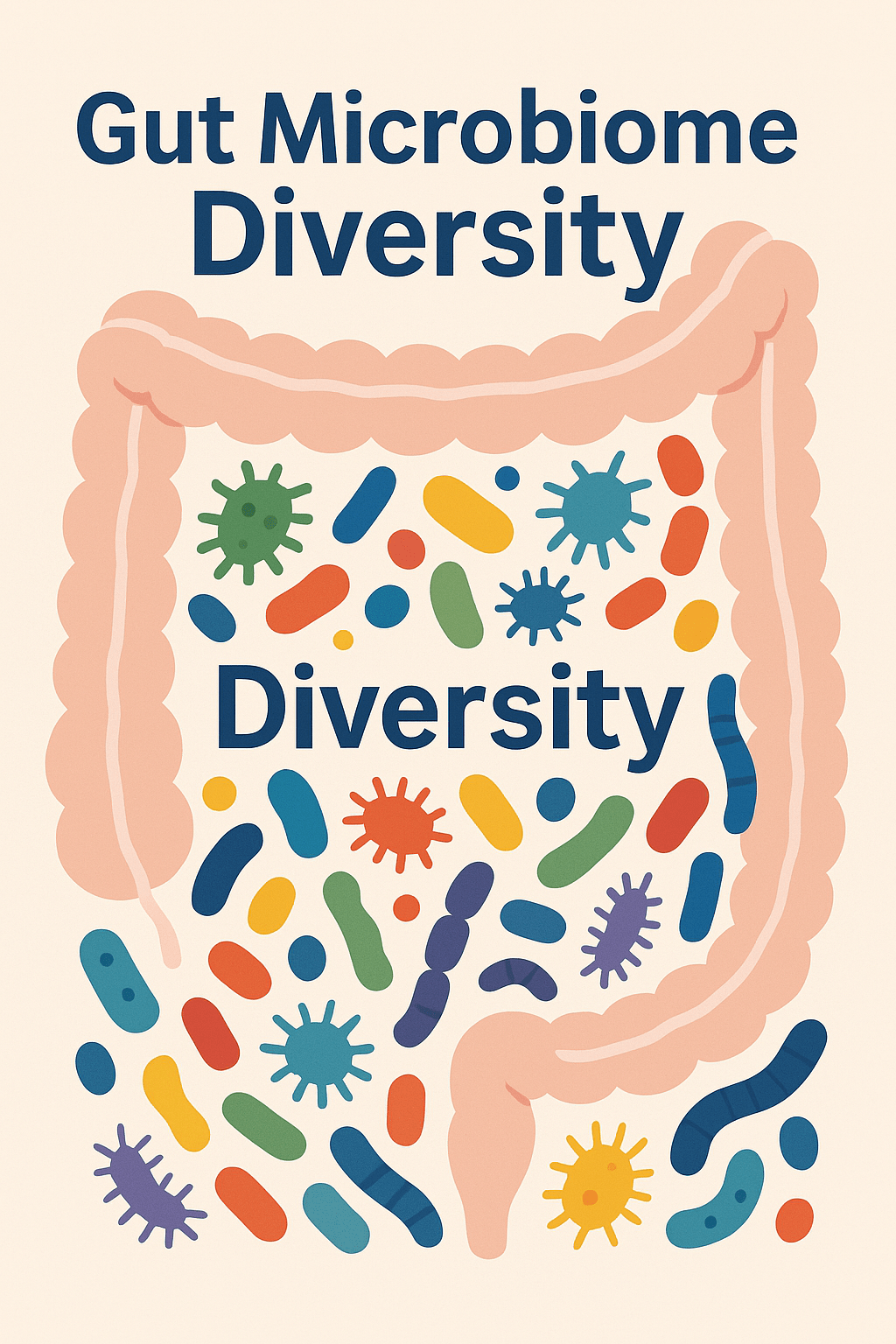
Microbiome Diversity: An Overview
Explore the power of gut microbiome diversity and its impact on your health. Learn how InnerBuddies uses cutting-edge science to personalize nutrition and boost well-being through microbiome insights.
Microbiome Diversity: An Overview
The term microbiome diversity refers to the variety of microorganisms, including bacteria, fungi, viruses, and archaea, that inhabit a particular environment, such as the human gut. Understanding this diversity is crucial for comprehending how these microorganisms interact with each other and with their host.
Importance of Microbiome Diversity
- Health Benefits: A diverse microbiome is often associated with better health outcomes, including improved digestion, enhanced immune function, and reduced risk of chronic diseases.
- Dysbiosis: A lack of diversity, known as dysbiosis, can lead to various health issues, including inflammatory bowel disease, obesity, and metabolic disorders.
- Gut Microbiome Diversity: The gut microbiome is particularly important, as it plays a significant role in nutrient absorption and immune system regulation.
Measuring Microbiome Diversity
Researchers use various metrics to assess microbiome diversity, including:
- Shannon Index: This index quantifies the diversity of species in a community, taking into account both abundance and evenness.
- Beta Diversity Measures: These measures compare the diversity between different environments or samples, providing insights into how microbial communities differ.
Understanding the Shannon Index
The Shannon Index, also known as the Shannon-Wiener Index, is a key measure used in ecology to quantify the diversity of a community. It takes into account both the abundance and evenness of species present in a given area, making it a vital tool for assessing microbial diversity in various ecosystems, including the human gut.
What is the Shannon Index?
The Shannon Index is calculated using the formula:
H' = -Σ (p_i * ln(p_i))
Where:
- H' = Shannon Index value
- p_i = proportion of each species (or operational taxonomic unit) in the community
Importance of the Shannon Index
This index is particularly important in the study of gut microbiome diversity as it helps researchers understand the balance of different bacterial populations. A higher Shannon Index indicates greater diversity, which is often associated with better health outcomes.
Applications in Microbial Research
In microbial research, the Shannon Index is used to:
- Assess the health of ecosystems by measuring bacterial diversity.
- Identify shifts in dysbiosis, which can indicate health issues.
- Compare beta diversity measures across different environments.
Understanding the Shannon Index is crucial for researchers and healthcare professionals alike, as it provides insights into the complex interactions within microbial communities. By measuring microbiome diversity, we can better understand the implications for human health and disease.
Exploring Beta Diversity Measures
Beta diversity measures are essential tools in the field of ecology and microbiome research. They help scientists understand the differences in microbial communities across various environments. By analyzing these differences, researchers can gain insights into the health and stability of ecosystems, as well as the implications for human health.
What is Beta Diversity?
Beta diversity refers to the variation in species composition between different habitats or communities. It is a crucial aspect of biodiversity that complements alpha diversity, which measures the diversity within a single community. Understanding beta diversity is vital for assessing the overall health of ecosystems and the impact of environmental changes.
Importance of Beta Diversity Measures
- Comparative Analysis: Beta diversity allows for the comparison of microbial communities across different environments, helping to identify unique or endangered species.
- Ecological Insights: By studying beta diversity, researchers can uncover patterns of species distribution and the factors influencing these patterns.
- Conservation Efforts: Understanding beta diversity is crucial for conservation strategies, as it highlights areas of high biodiversity that may require protection.
Common Beta Diversity Measures
Several metrics are used to quantify beta diversity, including:
- Bray-Curtis Dissimilarity: This measure compares the abundance of species between two communities, providing insights into their compositional differences.
- Jaccard Index: This index focuses on the presence or absence of species, making it useful for understanding community similarity.
- UniFrac: A phylogenetic measure that considers the evolutionary relationships between species, offering a deeper understanding of community structure.
In summary, beta diversity measures are vital for understanding the complexities of microbial communities and their interactions with the environment. By employing these measures, researchers can better assess the health of ecosystems and the implications for biodiversity conservation.
The Importance of Microbial Diversity
Microbial diversity plays a crucial role in maintaining the health of ecosystems and the organisms that inhabit them. It encompasses the variety of microorganisms, including bacteria, fungi, and viruses, that exist in a given environment. Understanding microbial diversity is essential for several reasons:
- Health Benefits: A diverse microbiome is linked to improved health outcomes in humans and animals. It helps in digestion, nutrient absorption, and immune function.
- Environmental Stability: Diverse microbial communities contribute to ecosystem resilience, enabling environments to withstand changes and recover from disturbances.
- Biogeochemical Cycles: Microorganisms play a vital role in nutrient cycling, including carbon, nitrogen, and phosphorus cycles, which are essential for ecosystem productivity.
One of the key metrics used to assess microbial diversity is the Shannon Index, which quantifies the diversity of species in a community. This index takes into account both the abundance and evenness of species, providing a comprehensive view of biodiversity.
Additionally, beta diversity measures are used to compare the diversity between different ecosystems or communities. These measures help scientists understand how microbial communities differ across various environments, which is crucial for conservation efforts and ecological studies.
However, a loss of microbial diversity, often referred to as dysbiosis, can lead to negative health outcomes and ecosystem imbalances. Maintaining a healthy gut microbiome diversity is particularly important for human health, as it influences various physiological processes.
In conclusion, fostering and preserving microbial diversity is essential for ecological balance and human health. As we continue to explore the complexities of microbial communities, it becomes increasingly clear that diversity is not just a measure of abundance but a cornerstone of life itself.
Dysbiosis and Its Impact on Gut Health
Dysbiosis refers to an imbalance in the microbial communities within the gut, which can lead to various health issues. Understanding the implications of dysbiosis is crucial for maintaining optimal gut health.
What is Dysbiosis?
Dysbiosis occurs when there is a significant shift in the composition of the gut microbiome, often resulting in a decrease in microbial diversity. This imbalance can be caused by factors such as:
- Antibiotic use
- Poor diet
- Stress
- Infections
Impact on Gut Health
The gut microbiome plays a vital role in digestion, immune function, and overall health. When dysbiosis occurs, it can lead to:
- Increased inflammation
- Digestive disorders (e.g., IBS, IBD)
- Metabolic issues (e.g., obesity, diabetes)
- Weakened immune response
Restoring Gut Microbiome Diversity
To combat dysbiosis and restore gut health, consider the following strategies:
- Incorporate a diverse range of foods in your diet, particularly those rich in fiber.
- Consider probiotics and prebiotics to support beneficial bacteria.
- Avoid unnecessary antibiotics and manage stress effectively.
As the renowned microbiologist Dr. Rob Knight states, "The gut microbiome is a complex ecosystem that requires balance for optimal health." By understanding and addressing dysbiosis, we can take significant steps towards improving our gut health.
Conclusion: Embracing Gut Microbiome Diversity
In conclusion, embracing gut microbiome diversity is essential for maintaining overall health and well-being. A diverse microbiome contributes to a robust immune system, aids in digestion, and plays a crucial role in preventing various diseases.
Research has shown that a rich diversity of microorganisms in the gut can lead to improved metabolic health and reduced risk of conditions such as obesity, diabetes, and inflammatory bowel disease. By fostering a diverse gut microbiome, individuals can enhance their health outcomes.
To promote microbial diversity, consider the following strategies:
- Incorporate a variety of fruits and vegetables into your diet.
- Include fermented foods such as yogurt, kefir, and sauerkraut.
- Avoid excessive use of antibiotics unless necessary.
- Engage in regular physical activity.
- Minimize stress through mindfulness and relaxation techniques.
As we continue to explore the complexities of the gut microbiome, it becomes increasingly clear that microbiome diversity is not just a scientific curiosity but a vital component of our health. Embracing this diversity can lead to a healthier, more resilient future.
In summary, microbial diversity is a vital aspect of health and disease. By studying the factors that influence bacterial diversity and the implications of gut microbiome diversity, we can better understand the complex relationships between humans and their microbial inhabitants.
As Albert Einstein once said, "Look deep into nature, and then you will understand everything better." This quote resonates with the ongoing research into the intricate world of microbiomes and their impact on our health.

